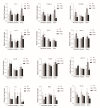Effect of Different Dietary Lipid Sources on Growth Performance, Nutrient Digestibility, and Intestinal Health in Weaned Pigs
- PMID: 37835612
- PMCID: PMC10571906
- DOI: 10.3390/ani13193006
Effect of Different Dietary Lipid Sources on Growth Performance, Nutrient Digestibility, and Intestinal Health in Weaned Pigs
Abstract
To investigate the effects of lipid sources on growth performance and intestinal health, 72 weaned pigs were randomly allocated to three treatments. Pigs were fed with a corn-soybean meal diet containing 2% soybean oil (SO), or fish-palm-rice oil mixture (FPRO), or coconut-palm-rice oil mixture (CPRO). The trial lasted for 28 days; blood and intestinal tissue samples were collected. The results showed that the crude fat digestibility of the FPRO group was higher than that of the SO and CPRO groups (p < 0.05). The FPRO group also had higher digestibility of dry matter, ash, and gross energy than the SO group (p < 0.05); compared to the SO group, the serum interlukin-6 (IL-6) concentration was decreased. Interestingly, the FPRO and CPRO groups had higher villus height than the SO group in the jejunum and ileum, respectively (p < 0.05). Moreover, the FPRO group had higher Lactobacillus abundance than the SO group in the colon and cecum (p < 0.05). Importantly, the expression levels of tight junction protein ZO-1, Claudin-1, and Occludin in the duodenal and ileal mucosa were higher in the FPRO group than in the SO and CPRO groups (p < 0.05). The expression levels of nutrient transporters such as the CAT-1, PepT1, FATP1, and SGLT1 were higher in the FPRO group than in the SO group (p < 0.05). The improved digestibility and intestinal epithelium functions, as well as the reduced inflammatory cytokines, in the FPRO and CPRO group suggest that a mixed lipid source such as the FPRO deserves further attention.
Keywords: growth performance; intestinal health; lipid source; weaned pigs.
Conflict of interest statement
The authors declare no conflict of interest.
Figures
Similar articles
-
Effects of single cell protein replacing fish meal in diet on growth performance, nutrient digestibility and intestinal morphology in weaned pigs.Asian-Australas J Anim Sci. 2013 Sep;26(9):1320-8. doi: 10.5713/ajas.2013.13200. Asian-Australas J Anim Sci. 2013. PMID: 25049915 Free PMC article.
-
Effect of fermented rapeseed meal on growth performance, nutrient digestibility, and intestinal health in growing pigs.Anim Nutr. 2023 Jul 16;15:420-429. doi: 10.1016/j.aninu.2023.06.011. eCollection 2023 Dec. Anim Nutr. 2023. PMID: 38058565 Free PMC article.
-
Effects of α-glycerol monolaurate on intestinal morphology, nutrient digestibility, serum profiles, and gut microbiota in weaned piglets.J Anim Sci. 2022 Mar 1;100(3):skac046. doi: 10.1093/jas/skac046. J Anim Sci. 2022. PMID: 35167667 Free PMC article.
-
Effect of β-Glucan Supplementation on Growth Performance and Intestinal Epithelium Functions in Weaned Pigs Challenged by Enterotoxigenic Escherichia coli.Antibiotics (Basel). 2022 Apr 13;11(4):519. doi: 10.3390/antibiotics11040519. Antibiotics (Basel). 2022. PMID: 35453270 Free PMC article.
-
Dietary protease improves growth performance, nutrient digestibility, and intestinal morphology of weaned pigs.J Anim Sci Technol. 2020 Jan;62(1):21-30. doi: 10.5187/jast.2020.62.1.21. Epub 2020 Jan 31. J Anim Sci Technol. 2020. PMID: 32082595 Free PMC article.
Cited by
-
Lipids in Clinical Nutrition and Health: Narrative Review and Dietary Recommendations.Foods. 2025 Feb 1;14(3):473. doi: 10.3390/foods14030473. Foods. 2025. PMID: 39942064 Free PMC article. Review.
-
Cellular effects of oral egg yolk immunoglobulin-based supplementation at birth on promoting growth and strengthening intestinal mucosal innate immunity in pre-weaned piglets.Front Vet Sci. 2025 Jul 16;12:1458279. doi: 10.3389/fvets.2025.1458279. eCollection 2025. Front Vet Sci. 2025. PMID: 40740302 Free PMC article.
-
Effects of Five Lipid Sources on Growth, Hematological Parameters, Immunity and Muscle Quality in Juvenile Largemouth Bass (Micropterus salmoides).Animals (Basel). 2024 Mar 1;14(5):781. doi: 10.3390/ani14050781. Animals (Basel). 2024. PMID: 38473166 Free PMC article.
References
LinkOut - more resources
Full Text Sources
Research Materials
Miscellaneous



